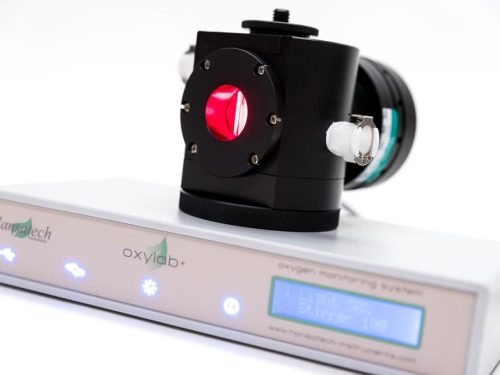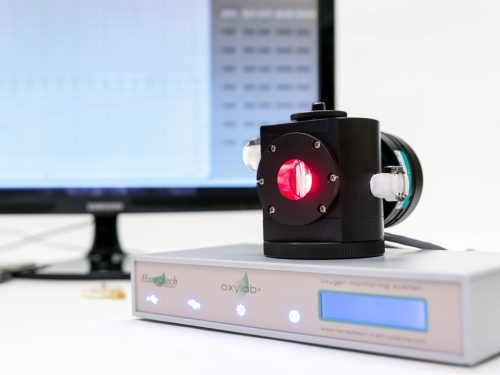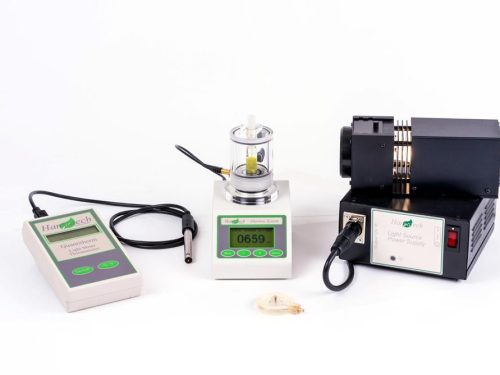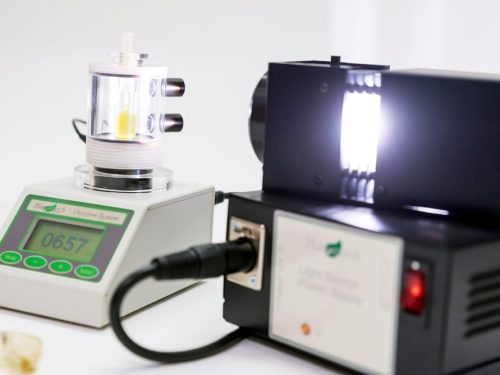S1 Oxygen Electrode Disc
Since its original design in the early 1970s by Tom Delieu and David Walker, the S1 Clark-type oxygen electrode disc remains largely unchanged – a true testament to the quality and reliability of the sensor. The S1 consists of a platinum cathode and silver anode set into an epoxy resin disc and is prepared for use by trapping a layer of 50% saturated KCl solution beneath an oxygen-permeable PTFE membrane. A paper spacer placed beneath the membrane acts as a wick to provide a uniform layer of electrolyte between anode and cathode.

When a small voltage is applied across these electrodes (with the platinum negative with respect to the silver), the current which flows is at first negligible and the platinum becomes polarised (i.e. it adopts the externally applied potential). As this potential is increased to 700 mV, oxygen is reduced at the platinum surface, initially to hydrogen peroxide H2O2 so that the polarity tends to discharge as electrons are donated to oxygen (which acts as an electron acceptor). The current which then flows is stoichiometrically related to the oxygen consumed at the cathode.

When connected to the electrode control unit, the S1 provides a fast, effective and accurate method of detecting small changes in oxygen concentration.
DW2/2 Electrode Chamber

The DW2/2 electrode chamber has been developed specifically to allow simultaneous spectroscopic and oxygen flux measurements. The reaction vessel of the DW2/2 is constructed from precision-bore borosilicate glass tube with a prepared S1 electrode disc forming the floor of the reaction vessel.
Precision temperature control of sample and sensor is delivered via a concentric water jacket with suitable connection ports for a thermoregulated circulating water bath. The water jacket is constructed from black acetal which provides the ability for dark adaptation of samples or oxygen measurement in complete darkness. There are four optical ports mounted perpendicular to the reaction vessel at right angles to one another. The LED1 LED light source supplied with the Chlorolab 2+ system fits directly into any of these ports for uniform and high-intensity illumination of the sample. Light sources, fibre-optic light guides and detectors may be interfaced via the ports on the DW2/2 enabling spectroscopic measurements to be made.
DW2/2 is fitted with a plunger with a capped central bore. The height of the plunger may be adjusted easily to suit liquid-phase sample volumes of between 0.2ml – 2.5ml whilst the central bore easily accommodates Hamilton-type syringes allowing additions/subtractions to/from the reaction vessel during an experiment.
Oxylab+ Control Unit

The next generation Oxylab+ oxygen electrode control unit combines striking aesthetics with enhanced features and functionality offering significant advances in flexibility and performance over previous generations of electrode control unit. As part of a complete system, Oxylab+ provides a convenient yet powerful tool for measurements of oxygen evolution or uptake across a broad range of liquid-phase samples from chloroplast extractions to mitochondrial suspensions with oxygen concentrations up to 100%.
Oxylab+ offers unrivalled price vs. performance combining simplicity of operation with an enviable feature set. The outstanding flexibility ensures Oxylab+ is equally useful in both a teaching and research capacity. 24-bit resolution allows detection of minute changes in oxygen tension without needing to apply instrument gain. This results in beautiful, noise-free traces even when zoomed close in on areas of interest. Integral electronics provide control over an LED light source with automatic intensity changes handled by user-defined PFD light tables in software.
The system allows real-time graphing of signals from auxiliary inputs and ion-selective electrodes providing scope for comprehensive analysis of oxygen activity simultaneously with signals such as pH, TPP+, calcium, potassium and hydrogen ions. Signals from all inputs are additionally displayed on an LCD screen mounted within the front panel of the Oxylab+ control unit.
Up to 2 individual Oxylab+ control units may be linked to a single PC and operated simultaneously from OxyTrace+ software providing a powerful, multi-channel system.
LED1 Light Source

A LED1 high-intensity light source in one of three colours is supplied with the Chlorolab 2+ system. The different light sources that can be supplied are as follows:
- LED1/R: red LED with a peak wavelength of 627nm
- LED1/B: blue LED with a peak wavelength of 470nm
- LED1/W: white LED with a colour temperature of 4100K
The graph below shows the spectral output of each colour of the LED1 light source.
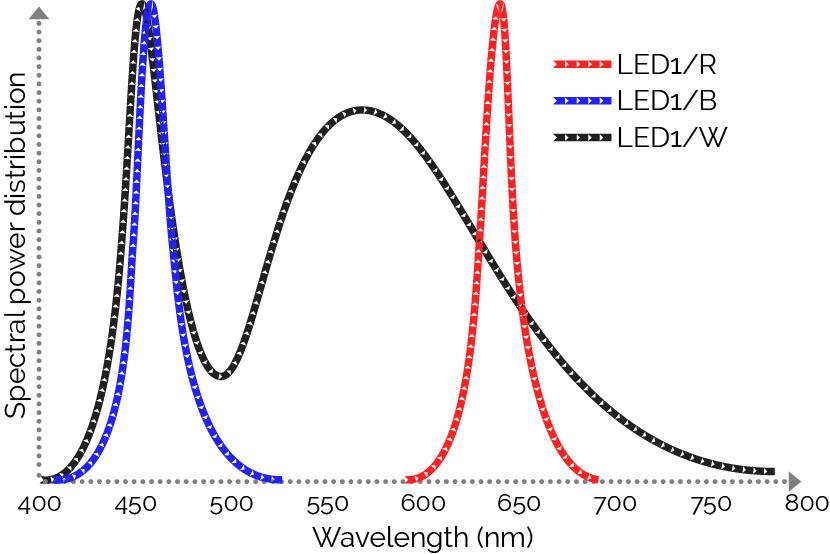
Light intensity adjustments are made automatically based on user-defined PFD tables within OxyTrace+ software. PFD tables consist of up to 20 individual steps allowing complex light response assays to be configured for automatic execution during a measurement.
Each of the LED1 light sources provide a maximum intensity of up to 2,000 µmol m-2 s-1 in DW2/2. Greater intensities are achievable by purchasing additional LED1 housings and an adapter which allows simultaneous automatic control of up to 3 LED1 light units.
QTP1 PAR/Temp Sensor
The QTP1+ probe sensor connects to the QRT1 control unit via a Mini-DIN connection. The probe is designed to be mounted directly into the DW1, DW1/AD, DW2/2, DW3 and Oxytherm+ electrode chambers via the use of suitable mounting collars (mounting collar for DW1 and DW2/2 supplied, collars for DW3 and Oxytherm+ supplied with respective items).
Despite being intended for light source calibration in liquid-phase oxygen electrode chambers, the PAR/temperature probe sensor must not be submerged in liquid. Although the probe is splash proof, prolonged contact with liquid will irreversibly damage the sensor. Calibration of light sources should be performed prior to the addition of samples. Damage caused by submersion will not be covered by warranty.
The probe consists of a PAR quantum sensor and a thermistor bead for temperature measurement and is constructed from stainless steel and acetal. Temperature is measured by an RT curve matched-type glass bead thermistor mounted centrally in the probe tip. Photosynthetically Active Radiation (PAR) levels are determined by a quantum sensor located in the side wall of the probe.
The QTP1+ probe may also be connected directly to the rear of the Oxylab+ oxygen electrode control unit. OxyTrace+ software plots the temperature signal from the QTP1+ in real-time as a chart recorder emulation on the same screen as the signal from the S1 oxygen electrode disc. PAR values are also displayed in the OxyTrace+ software light source calibration routine providing a convenient display of measured values during the light source calibration process.
OxyTrace+ Software
OxyTrace+ is a multi-function Windows® program supplied with our range of PC-operated electrode control units for system configuration, calibration, data acquisition and analysis.
In liquid-phase systems such as Oxygraph+, Oxytherm+, Chlorolab 2+ and Chlorolab 3+, an automated 2-step calibration routine guides the user quickly and effectively through the system calibration process using electrode values measured from air-saturated and deoxygenated water. For gas-phase systems such as Leaflab 2+, an automated 3-step calibration routine using electrode values measured from ambient air, ambient +/- 1ml of injected/removed ambient air and a further measurement of ambient air is employed.
For electrode control units that provide automated light source control in systems such as Oxytherm+P, Chlorolab 2+, Chlorolab 3+ and Leaflab 2+, OxyTrace+ allows simple configuration of comprehensive PFD tables consisting of up to 20 individual light steps. Light intensity adjustments are performed automatically during the measurement. OxyTrace+ also allows calibration of the light source from a simple software routine. This requires the QTP1+ PAR/temperature sensor to be connected to the rear of the electrode control unit and placed into the reaction vessel prior to the addition of any liquids. In the Leaflab 2+ gas-phase system, calibration of the LH36/2R light source requires manual input of measured values at each individual calibration intensity step using the QSRED quantum sensor.

A tabbed interface allows a simple transition between the different data views including oxygen electrode (and if configured, auxiliary and external ion-selective electrode) realtime output, a split screen showing realtime rate of change above the oxygen signal and tabulated numerical data.
Post-acquisition analysis tools allow automatic calculation of oxygen rates from user-defined rate intervals. For Oxytherm+P, Chlorolab 2+, Chlorolab 3+ and Leaflab 2+ systems, additional analysis tools automatically calculate rates of change for defined PFD light steps with a calculation of quantum yield presented at the end of a measurement. All files are saved as Comma Separated Values (CSV) data files opening effortlessly in external data processing packages such as MS Excel®.
OxyTrace+ will run on all supported Microsoft operating systems.
System Components
Chlorolab 2+ systems are supplied with the following components:
- DW2/2: Oxygen electrode chamber
- OXYL1: Oxylab+ electrode control
- S1: Oxygen electrode disc and SMB-SMB connection cable
- LED1: LED light source in choice of 3 colours:
- LED1/W: white LED (4100K – default option)
- LED1/R: red LED (627nm)
- LED1/B: blue LED (470nm)
- QTP1: PAR/temperature sensor
- A2: Membrane applicator to assist with smooth application of electrode membrane
- A3: Top plate key and alignment jig to dismantle and reassemble DW2/2 for cleaning
- S2/P: Pack of 5 magnetic followers
- S3: Pack of 2 replacement borosilicate glass reaction vessels
- S4: Reel of PTFE membrane (0.0125mm x 25mm x 33m)
- S6B: Set of replacement O-rings for DW2/2
- S16: Cleaning kit for the S1 electrode disc.
Technical Specifications
Oxylab+ electrode control unit
- Measuring range:
- O2: 0% – 100%
- pH: 0pH – 14pH
- Aux: 0V – 4.096V
- Signal inputs:
- S1 O2 electrode (SMB)
- pH/ISE (BNC)
- Aux (8-pin mini-Din)
- QTP1+ PAR/temp probe (6-pin mini-Din)
- Resolution:
- O2: 0.0003% (24-bit)
- pH: 0.0006pH (16-bit)
- Aux: 62.5µV/bit (16-bit)
- Polarising voltage: 700mV
- Input sensitivity: 0nA – 9,000nA
- Magnetic stirrer: Software-controlled 150rpm – 900rpm in % steps
- Sampling rate: 0.1 readings/s – 10 readings/s
- Electronics:
- Microcontroller: 16-bit high-performance CPU running at 32 MHz
- ADC: Dual, low-power
- 16/24-bit Sigma Delta
- Display: 61 x 2 character blue LCD
- Communications: USB 2.0
- Analogue output: 0V – 4.5V O2 signal
- Dimensions (HWD): 250mm x 125mm x 65mm
- Weight: 630g
- Power: 95V – 260V universal input mains supply. Output 12V DC 2.5A
DW2/2 electrode chamber
- Suitability: Liquid-phase photosynthesis/respiration
- Construction: Black acetal
- Sample chamber: Precision-bore, borosilicate glass tube
- Sample volume: 0.2ml – 2.5ml (1.5ml min. for illumination)
- Plunger: Variable-height, capped central bore
- Temperature control: Water jacket connected to circulating water bath
- Optical ports: 4 x optical port with 16mm diameter
- Dimensions: 105mm x 65mm
- Weight 400g.
S1 oxygen electrode disc
- Electrode type: Clark-type polarographic oxygen sensor
- Electrode output: Typically 1.6µA at 21% O2
- Residual current: Typically 0.04µA in 0% O2
- Response time: 10 – 90% typically <5 seconds
- Oxygen consumption: Typically <0.015µmol/hr-1
LED1 light source
- Light source: Single LED
- Control: Via Oxylab+ and OxyTrace+ software
- Wavelength:
- LED1/W – 4100K (colour temperature)
- LED1/R – 627nm peak wavelength
- LED1/B – 470nm peak wavelength
- Cooling: Integral automatic cooling fan
- Intensity: 2,000 µmol m-2 s-1 (greater intensities possible with multiple LED1 units)
- Dimensions: 64mm (dia.) x 60 mm (h).
- Weight: 270g.
QTP1 PAR/Temperature sensor
- PAR sensor: Silicon photodiode and optical filter with white acetal diffuser
- Temperature sensor: RT curve-matched bead thermistor. 0°C – 50°C/32°F – 122°F (0.02°C resolution)
- Dimensions: 9.5mm x 107mm. Weight 50g
Publications
One of the extensions of the Google search facility is Google Scholar. It allows you to search through vast archives of peer-reviewed published papers and journals that have been posted online.
Use the tool below to enter search terms as required. As an example, hansatech instruments Chlorolab 2+ System has already been entered into the search box. Press the "Search" button to view the Google Scholar results for this search string.
Admittedly, some of the results link to journals which require subscription in order to view the publications but even so, we have found this facility to be a valuable tool.

Download the Chlorolab 2+ System Brochure















